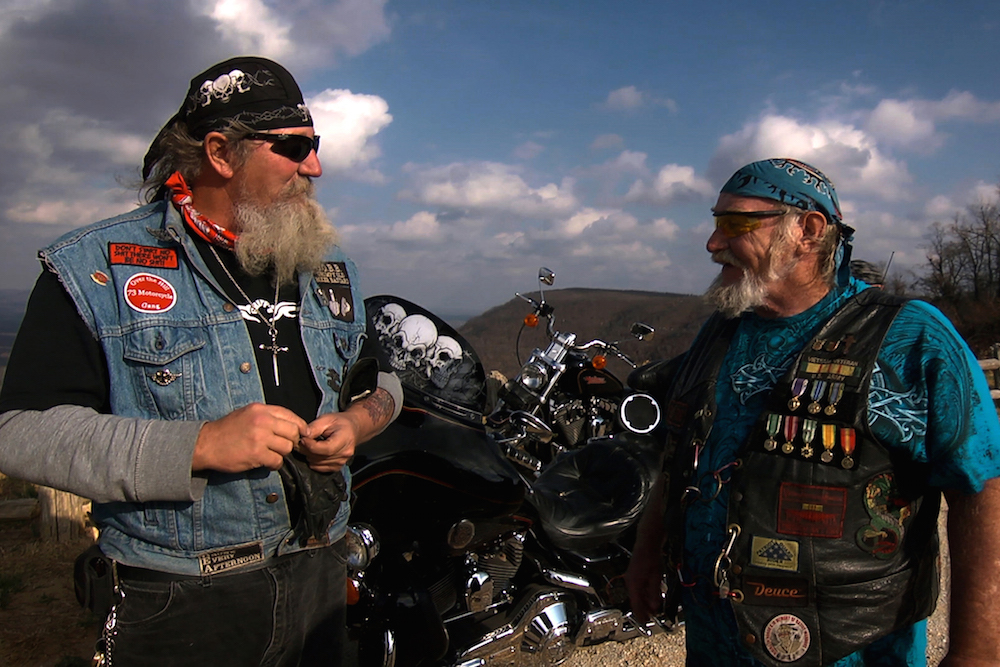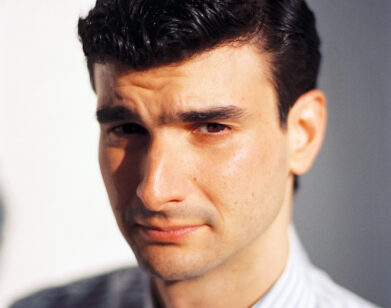Debra Granikâ??s Bark and Bite

RON “STRAY DOG” HALL (RIGHT) IN DEBRA GRANIK’S STRAY DOG. PHOTO COURTESY OF STILL ROLLING PRODUCTIONS.
Debra Granik is especially adept at drawing minute portraits of personalities lifted from the harsh realities of the everyday. The filmmaker’s previous narrative features Down to the Bone (2004), an account of a working class mother’s coke addiction, and the Sundance darling Winter‘s Bone (2010), the journey of a steely young woman navigating the meth-addled backwoods of the Ozarks in search of her absentee father, propelled their stars (Vera Farmiga and Jennifer Lawrence, respectively) to break out in Hollywood. It’s a natural progression that her first documentary feature, Stray Dog, out tomorrow, offers a multifaceted, achingly emotional anthropological study of life in the rural American heartland.
By chance, Granik met Ron “Stray Dog” Hall in a church in anticipation of Winter’s Bone, and subsequently cast him in the role of drug kingpin Thump Milton. After production wrapped, Granik formed a rapport with Hall, and over two-and-a-half years, returned to Southern Missouri to capture the gregarious Vietnam war vet and biker in his natural milieu, where he oversees an RV park, cares for his dogs, engages in veteran outreach, battles with the lasting PTSD effects of his multiple tours in Vietnam, and rides in the “Run for the Wall” cross-country motorcycle pilgrimage to the Vietnam War Memorial in Washington, D.C. Despite the economic austerity of the region, and the reminders of the past, Hall continues to push for optimism, whether in trying to help his daughter and newly pregnant granddaughter make ends meet, or studying Spanish for his new wife, Alicia, who emigrated from Mexico, and her two sons, who moved to the States to be with her.
While Granik’s camera attests to the region’s specific tastes—like line dancing, moonshine, and a fondness for firearms—the heart of Stray Dog depicts a complex representation of contemporary America, its shape-shifting, ethnic and socioeconomic lines, and how those affect those living in it. We spoke with Granik earlier this week in New York about what she calls “the bullet of emotion,” warrior psychology, and delving into the masculine psyche.
COLLEEN KELSEY: I went into this film with a certain idea of how it would be, and then left with a completely different one. I know you met Ron on Winter’s Bone, but when did he reveal himself to be a subject you’d be interested in for his own film?
DEBRA GRANIK: Upon meeting him in his real life location. I only knew him in the context of the chance encounter, first meeting him in a church. On the set [of Winter’s Bone], he was doing something very specific. I did notice that he was congenial and had this interesting repertoire of icebreakers. Given the whole leather, the chain, the biker, I was thinking he would be a much more reserved or intimidating person. Within that cladding, there was someone who earnestly sought out people who were different from himself and would put out this olive branch. But we were in the middle of trying to film, and also we were casting him more like what the armor was.
Upon saying goodbye to him, Anne Rosellini, who produced the film, and I drove back to say thank you. He gave us a brief, not a tour, but he said, “These are my friends and neighbors. I run this park.” He had this pretty big responsibility as caretaker for a small community, the dogs. It was unmissable that they were surviving in a kind of American poverty…living in it, but surviving it. So, it’s like a dam opens and an onslaught of themes hit you straight away. But it wasn’t like, oh, light goes off, let’s film him! We had to come back to pick up some sound and he told us a couple stories. It was a soulful storytelling. He was telling me something very difficult that never made it into the film, but there was such an “and.” I think many filmmakers are always looking for the “and,” because it’s what makes reduction so difficult. It’s what makes us think. Someone can do this and this. Can feel this and this. Not or—and. What a complicated thing! We’re repulsed and attracted, we’re intrigued and disturbed, saddened and see hope. He’s someone who just comes out with a tray of ands. I’m also someone who’s looking for hope. Ron had a curious path to hope because he wants so badly to make life work. As you can see, it was a big bundle.
KELSEY: Something that was so fascinating to me was the sense of tradition. Whether that’s something like the military, or Ron’s connection to his region, the community around him, who have their own rites and ways about them, and the same for the bikers.
GRANIK: Really ancient history. I mean, the rituals that bikers participate in go back to the days of knights.
KELSEY: Ron is folded into all of these different communities. I think something that unites them is they are communities that are not so visible to a person who’s on the East Coast or the West Coast, in a different class or walk of life. Vietnam veterans dealt with visibility after the Vietnam War and certainly are less visible now in the grand scheme of things. But these people still have their struggles and still need to make a life and need to get better. Were all these cleaving, overlapping themes something that you wanted to examine?
GRANIK: You’ve enumerated the themes very astutely, and it becomes very hard in editing. There are themes that are very hard to tease out. They’re very internal. We were also privy to a lot of context and backstory. Ron feels like, for Iraq and Afghanistan, there’s a true understanding of the class analysis of who goes to war, who gets harmed, what families surrender and sacrifice. There’s a much deeper understanding, finally. Even with all that introspection and probing of the ’70s, it was so complicated. Ron has very complicated views about it. Someday it’d be powerful to have him do a monologue just to really understand when your government tells you someone is your enemy, and to question that! That’s a big theme that never really made it into the film in an overt, stated way.
Even though Ron can be very classically patriotic, I appreciated that within that there was this questioning, and this desire in him to scratch back and look inside. But these are themes about thinking and feeling, and that is hard. So we were also blessed with some really visual, onscreen, present-time things. Like, the man decides, for whatever reason, to complicate his life hugely by falling in love with a woman in Mexico. She’s entering his world and pushing and pulling on it and questioning it herself. Then along come her two children, Jesus and Angel, who she’s extremely still connected to, who must be part of the picture.
KELSEY: I think he goes with it as gracefully as possible.
GRANIK: It’s funny, and he would say this is a characteristic of a lot of soldiers—he began to view it as a mission. It’s a part of warrior neurochemistry that I’m fascinated by. The immigration process is so unbelievably complicated and expensive and endless! By the time you’re told you need your eightieth fingerprints, and your cornea scan, or whatever it is, and everything costs money…He had this folder that was bulging, he kept rereading it, he crossed his t’s, dotted his i’s and was just very determined.
KELSEY: Watching the film and seeing his narrative with Alicia go one way, and then once the boys come into the picture, there is the unspooling narrative about immigration, about what America means to other people, refracted through Ron’s own complicated relationship with his country, especially in a place like Missouri, which is really the seat of heartland America. There’s that one moment where one of the boys is on the phone to his girlfriend, talking about what he thought it was going to be like once he moved to the U.S., versus what life is like in Mexico City, that really throws things into relief.
GRANIK: That’s something that just upends and classifications of what worlds we live in, right? First, they came from one of the world’s largest megacities, a metropolis beyond belief, that they knew how to navigate. They were sophisticated. We had some wonderful shots of them that we had to cut, in Mexico City with their pals, just getting their hair cut in a local shop there. They could see right away the minute they met the man, how different they were in terms of lifestyle and what they’d been exposed to. It’s interesting: we were privy to a conversation where Alicia was truly trying to level with them. She knew what [Ron’s] place looked like. Still, there’s no way to prepare someone. A throughline actually, was teeth. Before [Ron’s friend] Bobby faces that issue with his teeth, Alicia had questioned why so many people have dentures. There’s a lot of scenes with Ron’s dentures. There was a scene that was very touching in DC, where they’re on the ride, in the motel room where she asks, “When did you lose your teeth?” He gives this incredible description of losing half of them in Vietnam and a Vietnamese woman dentist who pulled them because he was in a lot of pain. That was a surreal story! But that was very backstory-ish. It was hard to know how to really integrate that because the film running time was just enormous.
KELSEY: And teeth are another marker of privilege.
GRANIK: And human health, what your society can afford, or is willing to do on your behalf. Alicia, meanwhile, every time they’d go to the border, on the Mexican side, like many Americans, she would get high quality dental work that she could afford. The ironies were abounding. It was hard to show that. If we had filmed in a dental clinic in Juarez when she was getting some work done, that juxtaposition in Mexico with the dental clinic in Missouri would have been powerful.
KELSEY: How did you decide what to lose?
GRANIK: That’s where the gift of an editor’s brain comes in. The editor of this one was Tory Stewart. You coddle it for a long time, you show your closest colleagues a large assembly that’s four hours that has most of what you think is stellar. Then you realize that because you’ve been privy to backstory and context, some viewers will not understand. Some viewers will get very hung up on chronology. You need to contextualize. It’s very hard. We put some stuff, deleteds, that we had this deep affection for on the website, actually.
KELSEY: How long did you spend with Ron filming the footage?
GRANIK: It was about two and a half years. We’d go for these intensive increments, 10 days or a week, where we would just follow. The bike ride was a really long one, where we started in Missouri and followed him cross-country with the pilgrimage, if you will. Others were just trying to stick to him, whatever was going to happen. That’s where we have a lot of scenes we actually don’t have in the film: a laundry hut would be erected in a couple days; or there’d be some kind of wonderful karaoke barbecue. Ron, and other bikers and other civic groups, they find ways to pepper life with small things. A chili supper; a Christmas party; a covered dish event. We have that one barbecue where he welcomes Angel and Jesus, but there were other ones that we also loved.
KELSEY: What do you think is Ron’s relationship to seeing himself, his life, and his history, and the history of his peers, in a movie?
GRANIK: I think Ron’s very conflicted. I think he’s very afraid, as is culturally appropriate in his region, of aggrandizing himself. He will say all the time, “I am one of many.” He really believes that. If we see him, it’s because he’s allowed us to see the facets of him. At the same time, Ron is also performative. Ron enjoys karaoke. Ron enjoys being able to stand up there and welcome Jesus and Angel. It feels good to him. Another scene that we cut was a scene where he volunteered to be a Santa at this event up at the community center. He had a terrible time getting his beard straight and he came out looking truly deranged! Some of the holes in the beard weren’t aligned correctly; it looked wild. But he came out with such a swagger. Ron does hold very fast to, “If I can do it…” It’s a weird kind of convulsive macho thing. Like, “If I can do it, brother, you can do it! If me, Ron, big Ron, can deal with a therapist, brother, you can do it.” That phrase is pretty darn sincere. I think that Ron knows that he stretched himself to be able to even contemplate the fact that there’s merit and meaning to a therapist, and facing the discomfort of emotions that swell up inside of you.
KELSEY: Well this is actually one of my other questions: You’ve made films with very strong female protagonists. How was it diving into this well of masculinity? All of these organizations carry these totems of macho-ness, whether it’s the military, or bikers, and then someone like Ron embodies these attributes, but subverts them.
GRANIK: And he gets lost and confused a lot, especially when he can’t help. That’s the bullet of emotion, ironically. “The bullet of emotion,” a phrase I use, it’s the same Sam Fuller used. He has some amazing quotes about that. It doesn’t matter how armored up you are, or how much combat experience you have, there’s these bullets that we try to duck and avoid more than any other kind. We’re so afraid of them, and Ron is not exempt from that. I am interested in how people process the stuff that’s really hard for them, man or woman. Also, in the search for hope, I love when men extend kindnesses to each other. As an anthropologist born into a female body and female neurochemistry, I’m just like, oh my goodness—look how they drink their coffee! Look how they do this!
STRAY DOG OPENS JULY 3 AT FILM SOCIETY OF LINCOLN CENTER. DEBRA GRANIK WILL BE IN PERSON FOR A Q&A FOLLOWING SCREENINGS AT 6:45 PM FRIDAY, AND SUNDAY AT 4:30 PM.






